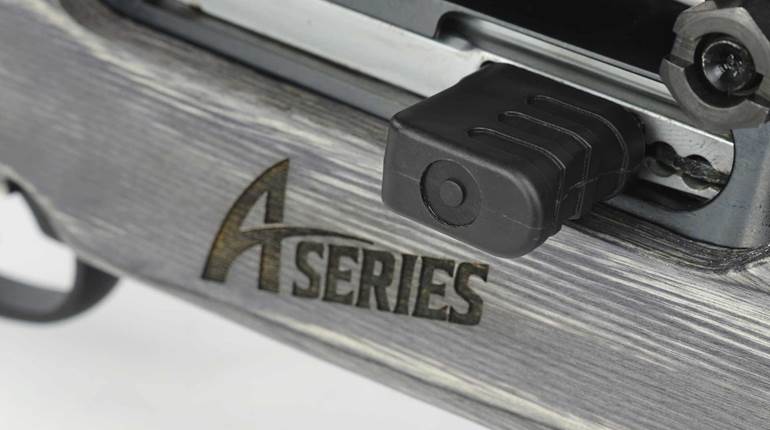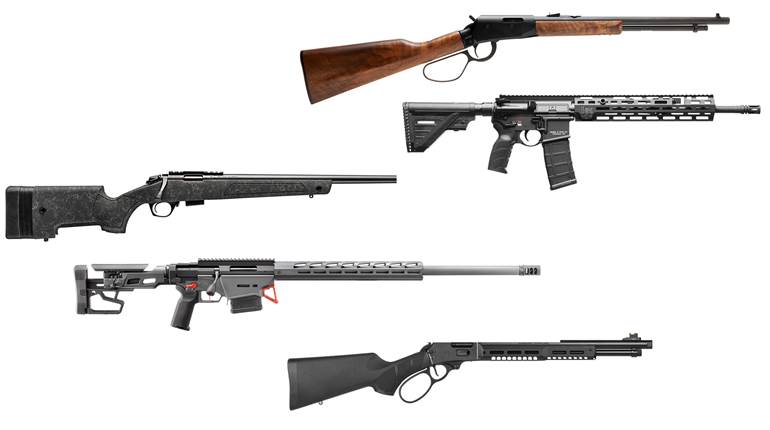
Incorporating two of the features for which the company has become most-known in modern times, the AccuStock and AccuTrigger systems, the Savage Model 111 Long Range Hunter is equally at home in big-game hunting and long-range shooting applications. A mid-weight bolt-action rifle available in nine chamberings, from .260 Rem. to .338 Lapua Mag., the subject of this review is a Long Range Hunter chambered in 6.5 mm-284 Norma—a cartridge chosen for both its utilitarian appeal and long-range accuracy.
The Long Range Hunter wears a soft-to-the-touch composite AccuStock to which its barreled action is attached. Two features truly make it a dual-use rifle. One is an adjustable comb on its buttstock that customizes cheek weld so that the shooter’s eye aligns with the scope perfectly for every shot, regardless of body type, scope height or shooting position. A consistent cheek weld is a key component of long-range accuracy. Cheekpiece removed, the buttstock becomes a downward-sloping, straight-line rifle stock, but with a couple of 3/8" holes drilled through it. A look through those holes reveals that the stock is not hollow, but rather filled with polystyrene—another name for Styrofoam.
Secondly, and at the other end of the rifle, the Long Range Hunter comes standard with an adjustable muzzle brake. The brake is a 2"-long, 3/4"-diameter steel sleeve that features 36 uniform, 1/8"-diameter ports. It’s partially threaded onto the barrel and pinned in place by the muzzle’s crown. With a simple quarter twist, the shooter can choose whether to allow the gases to pass through the brake or not, effectively turning it on or off.

Turned clockwise, the ports in the sleeve do not align with the barrel’s ports, and therefore gases from the fired cartridge are forced out of the barrel normally. This results in a shot that has a full recoil value, but one that isn’t as perceivably loud as a rifle with a muzzle brake. However, if the shooter finds himself in a scenario where recoil mitigation is important, a simple counterclockwise twist aligns the sleeve’s ports with the barrel’s ports, so that gases can escape in a 360-degree pattern around the barrel, thereby countering the rearward forces of recoil and mitigating them. In testing, turning the brake on and off did not affect point of impact.
The medium-contour, chrome-moly steel barrel is 1.02" in diameter before tapering to 0.734" at the muzzle. The 6.5 mm-284’s barrel is rifled with a 1:8" twist and, although listed as 26" long, actually has 24" of rifled bore to which the 2" brake is attached.

Savage’s oft-copied barrel nut can be precisely adjusted for headspace by the barrel installer, and the Long Range Hunter takes full advantage of the system, which no doubt contributes to the rifle’s accuracy. Another factor is its bedding system; one recoil lug is sandwiched between the barrel nut and the receiver to provide a recoil block into which the action is mated with the stock.
Savage’s proprietary AccuStock features a monolithic, milled-aluminum bedding block that traverses the entire length of the action, from the rear action screw to the fore-end’s sling swivel stud. The aluminum chassis is epoxied into the stock so it will not budge. The barreled action is then screwed down onto the block, so that the action screw attachment points are unwavering metal on metal. The barrel remains free-floated. A slender 9¼" tongue runs most of the length of the fore-end to give it rigidity so that it’s impervious to fore-end pressure. This entire system does away with meticulous hand bedding because the barreled action and the aluminum chassis to which it is mated are precision-machined, so bedding is consistent and repeatable via the action screws.
The bolt is distinctly Savage: A dual-lug head is backed by a gas-escape baffle, and a plunger-style ejector lies in its recessed face. A sliding-plate extractor is incorporated within the bolt’s right lug. The knurled, round knob of the bolt handle is equally suitable for target shooting and hunting scenarios.
Attached to the action is Savage’s renowned AccuTrigger. User adjustable, it allows crisp, sub-2-lb. trigger pulls to also remain safe and incapable of misfiring due to drops or jars. In testing, the Long Range Hunter’s trigger proved to be highly consistent; the test unit’s trigger had a standard deviation of +/- 0.3 ozs. A simple, forward-to-fire, rear-to-safe, tang-mounted safety features three positions for locking the bolt closed or allowing it to be cycled while keeping the rifle on safe. An internal magazine with a hinged floorplate holds three rounds.
The only complaint generated throughout testing was the significant force required to work the bolt after firing several types of 6.5 mm-284 ammunition. While this is more than likely a product of hot ammunition and not the rifle, it’s worthy of mention. Regardless, the Long Range Hunter was capable of five-shot, 1" groups at 100 yds. with various types of ammunition. It seemed to recoil less than expected thanks to its brake, a generous recoil pad, 8-plus-lb. heft and tailored cheek fit.

The Savage Model 111 Long Range Hunter’s adjustable comb, on-off muzzle brake and 1 m.o.a. accuracy potential make it a real value at the rifle’s suggested retail price of $1,171. Riflemen attempting to select a do-all rifle for both target practice and for hunting North American game will likely find it to be a worthy out-of-the-box option.







































